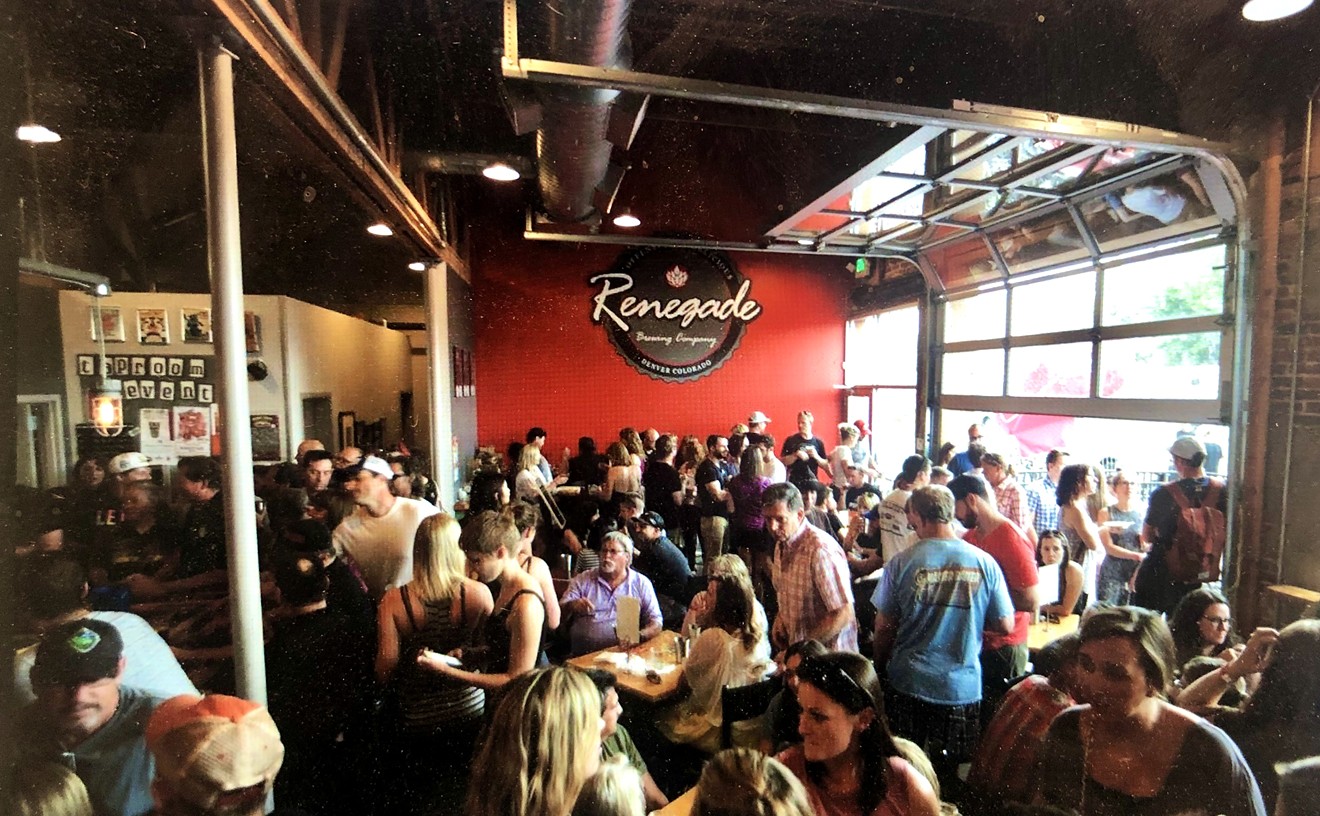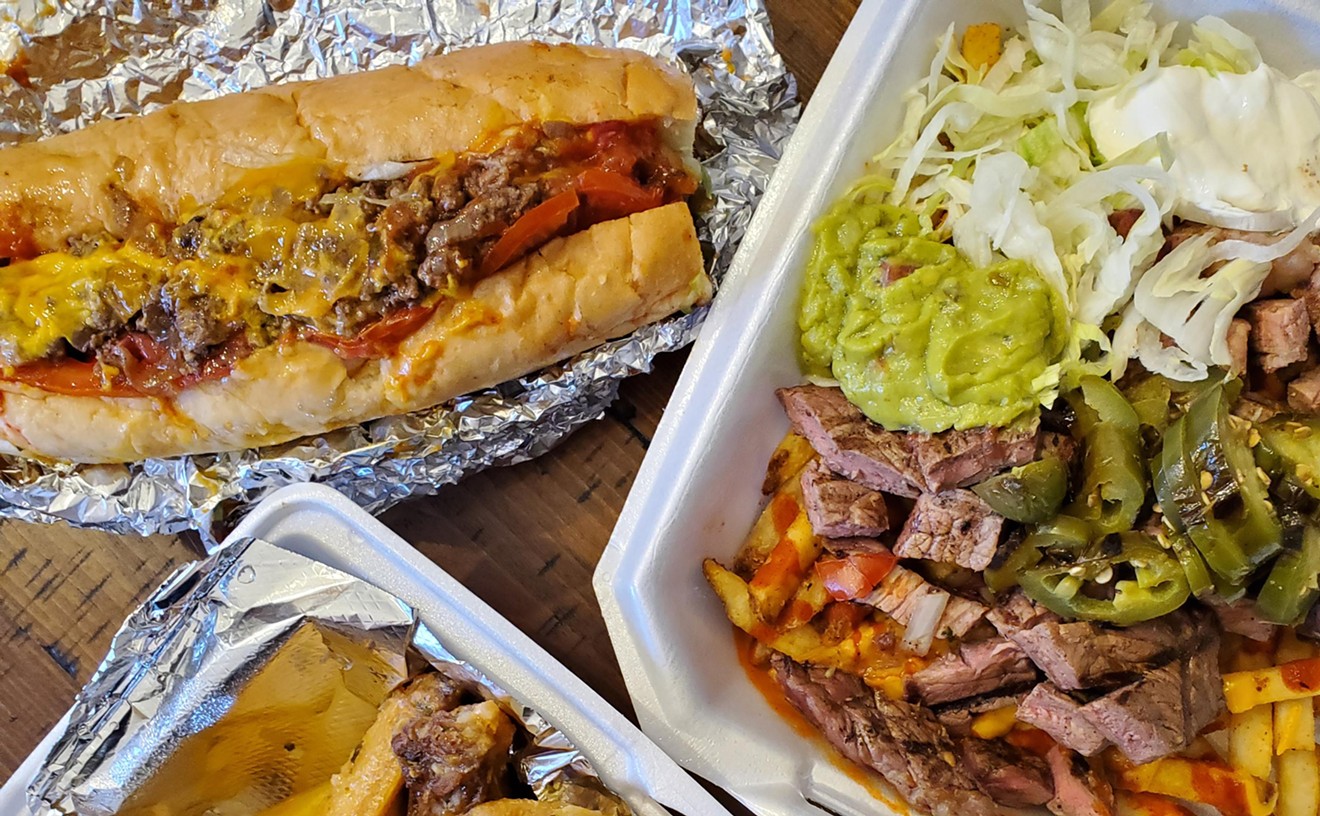While he's made a name for himself in the local music scene (playing in the bands Moccasin/Nightingale and Dario Rosa, among others), this will be owner Scott Bagus's first foray into having his own restaurant. He's joined by Eric Johnson, who spent eight years as the chef de cuisine at the Flagstaff House. We recently toured the renovated space, checking out the 45 singles jukebox and new wooden tables, and then grabbed Bagus and Johnson from their round-the-clock construction schedule to chat about sustainability, local music and why so many chefs are intimidated by a vegan-friendly menu.
See also: Old Curtis Street's last hurrah
Westword: Opening a restaurant is a far cry from performing rock music -- was this always a dream of yours during those years?
Scott Bagus: Not necessarily a restaurant, but I've always wanted to have a cozy little, lounge-type neighborhood bar. Something cool for Denver. For a long time I wanted to open a place called The Moss Lounge, where everything was covered in velour and there was actual moss growing on the walls.
So I always had a fantasy about it, but when we first signed the lease it wasn't going to be this big of a thing. I just thought we'd just do something small. And then I was like, if I'm going to do this, I need to just go big.
What do you mean, go big?
Bagus : Well, I was looking at this really big kitchen, and I thought it should be utilized somehow. So I found this really good chef, Eric, who'd worked at the Flagstaff House in Boulder. At first I just wanted to consult with him; Forest Room 5 has a menu consultant who plans the menus and teaches the cooks. So I wanted to do that, or find some younger chef who could come up with a creative menu. Because I'd never done anything like this before; it was all new to me.
So Eric came down and checked out the place and the neighborhood, and was like, "I could consult with you over the phone, or help you plan a menu -- or if you want me to be your chef, I could give my two weeks' notice." I didn't expect him to say that.
Eric Johnson: My brother-in-law had an old music association with Scott. And he suggested Scott get a hold of me, and I could give him some advice. I had a good job, and wasn't really looking for anything. But I got to talking to Scott and really liked his vision and concept.
And what was that concept?
Johnson: Sustainability. Scott really ascribes to the idea of not wasting things and to reusing things: buying local, working toward a low carbon footprint. That was something that is really important to me as a chef. There's so much waste in this industry, on all sides of it.
And you're also bringing in all local produce?
Johnson: Yes. Lately there are so many great farms in the Colorado area where you can get your produce locally. A lot of them have hothouses, or hoop houses, and the season when you can't get anything here is pretty brief. Some times you do have to get stuff from California.
In the summer time you can get pretty much anything you want in Colorado -- not quite everything, but pretty close. And that's something that we want to support. The most difficult part is the farm-to-table meat supply. Historically all these farmers have been feeding into these huge supply chains; so while there may have been a farmer out in eastern Colorado, you couldn't just go to him and get it, because his meat was going to this big distributor.
But lately there have been all of these systems where you can get to the source, and that's really cool to support as a chef. But they have to take on all these costs to run their own business. It's difficult for them to come to the market, instead of going to a big supply house.
So when Scott approached you with the idea of this restaurant, did he have a clear idea in mind of what the menu would look like?
Johnson: He had an idea in principle, but in practice he didn't have a way to actualize it. And that's where I came in. I took his idea and brought it to life, and it dove-tailed with what I wanted to do. We're not breaking any culinary ground here. It's very ingredient-driven, there's no super-fancy preparation. It involves classic techniques with a modern sensibility. We incorporate all different cuisines, which is really what New American cuisine is now: There are no rules. I'm not doing world cuisine, which is broader, taking different dishes from all over the world and putting them on the menu. With New American cuisine I'll use ingredients that are in that classic dish in Asia or South America, and then make a dish with my own interpretation.
In the scene where I assume you guys will have a big draw, dietary restrictions are a big part of eating out. What is your approach to requests for vegan or gluten-free options?
Johnson: Oh, yeah, the scene counts when you're dealing with a restaurant. That's just part and parcel of being successful. We're in the service industry, and we should be able to take care of people. They shouldn't feel like their needs are difficult to accommodate. Today there are so many ways to do the gluten-free thing that there's almost no reason to have flour or gluten in your kitchen. And if you want, you could flip it around and identify the things that have gluten on the menu.
Is that what you're doing?
Johnson: Essentially. We want to have the menu be really clean, so we're not going to be identifying anything. This will have more to do with server-training. You'll have no problem being gluten-free here; most people will understand it by just looking at the menu.
We're trying to incorporate a lot of organic options. And we'll have more than a token dish for vegetarians or vegans. It's such an easy thing to do, and I don't know why more chefs don't do it. They look at it as a fringe thing, and don't give it as much respect as it deserves. Vegetarians and vegans should be entitled to all the creative energy and resources that that chef has.
I think a stigma a lot of chefs have is that vegetarian food is terrible, that you can't make a strong menu with those restrictions.
Johnson: Right, so why bother? They don't want to be labeled. It's something I embrace, with one dish I left it wide open for myself and the others in the kitchen to create on the fly: The vegetarian carnival. It's like taking the best we have in the house, and making into one large sample platter; but in a nice clean way, tightly presented. It's an opportunity for us to be creative as far as what we can offer.
Did you ever come down here during the Old Curtis Street Tavern days?
Bagus: Yeah, I'd come down here to drink and hang out. I didn't see too many bands -- I've never been into many punk and hardcore bands. I did see some metal bands I really liked.
Is there anything from that era that you'd like to preserve, or does Old Curtis hold no sentimentality for you?
Bagus: Not really so much -- but we wanted to keep the name, so we called it the Curtis Club. It's really more of a revival of the space, rather than of that whole era, scene, place and time. I wouldn't really know how to preserve it. To me, it didn't hold a very special place in my heart. I'd come down and see friends sometimes, but there are other places around Denver that are more sentimental to me.
The reason I ask is because there are so many bands, comedians and just young drinkers who had a lot of their seminal experiences here. Do you think there will be any suspicion from that crowd of what you're doing with an iconic venue?
Bagus: Oh, I'm sure. Actually, I was out here last night, and this young drunk kid came by, looked in the window, and was like, "Bring back Old Curtis Street! It better be cool in there, motherfucker!" My friends that were working with me here had hung out at Old Curtis, and they were all laughing. I like that.
But it's just not going to be the same. I'm sure a lot of the old patrons will have a weird feeling about it, but also I know that so many other kinds of people are going to be able to access this space now. I want it to be comfortable for everybody. I think it will be better in that regard; you can get more out of it. You'll be able to see music, have good food and drinks; it's more of a cozy, social place.
People can come out and have dinner, and then we'll have some late-night entertainment of live music or a DJ.
It feels like this neighborhood has somewhat of an identity crisis lately. Since Old Curtis and The Wave closed, and Bar Bar has attempted to revamp its image with espresso and wifi, there isn't the skid-row romance there once was. But there isn't really a clearly defined identity yet like other neighborhoods have. Bagus: Yeah. But we are a different type of concept than those LoDo bars, or the Larimer bars by the baseball field. I actually want to go back even further in time with this, looking like the lobby of an old West Denver hotel. I'm really fascinated by the old West, and want to put my own spin on it.
But it does have a very contemporary culture feel in terms of the concept, menu and demographic. What separates Curtis Club from a place like City, O' City?
Bagus: Well, City, O' City is vegetarian-only. We serve veggie stuff. Though everything in here -- and I know this is a kind of catch-phrase -- will be organic, farm-to-table. But more than just lip-service to the trend, we are very passionate about where our food comes from, how it's raised, and what goes into it.
And that is one way we're similar to City, O' City. But the crowds are going to be more mixed. People in their early twenties to mid-thirties mostly hang at City, O' City, but here the menu is maybe a little bit more -- and I don't want this to come off snobby -- but a little more sophisticated to the palate. So here we'll get a younger crowd, and then also people well up into their sixties. I don't know if we'll really get any rock bands in here.
That was something I was curious about. You mentioned having music and DJs, but what did you have in mind since you want Curtis Club to be more of a restaurant than a venue?
Bagus: Well, I'm thinking something more mellow, where if people are dining it won't be offensive. Aurally offensive. If there's a couple having a romantic time together, you don't want something loud and harsh in there. Though I guess that could be romantic to some people.
Also, there are so many venues run by friends of mine, and I don't want to step on anyone's toes. They're doing such a good job, and I want to steer clear of that. We might have some Motown or some indie-folk or jazz or blues, nothing cheesy. Just to create a vibe or an atmosphere. I'm pretty picky about my music.
The Curtis Club will celebrate its grand opening from 11 a.m. to 2 a.m. on Friday, November 1.
Follow @CafeWestword










